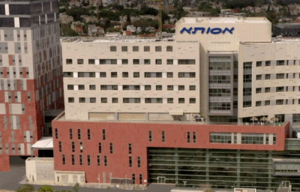Nephroblastoma (Wilms Tumor)
Disease description
Nephroblastoma, also known as Wilms tumor, is a rare, highly malignant embryonal kidney tumor that predominantly occurs in children, most commonly between the ages of 2 and 5. This type of cancer is named after the German surgeon Max Wilms, who first described the disease in the early 20th century. Nephroblastoma accounts for approximately 5-7% of all pediatric malignancies. Despite its aggressive nature, it generally responds well to treatment, especially when diagnosed at an early stage.
Nephroblastoma primarily affects the kidneys — vital organs responsible for blood filtration and excretion of metabolic waste. The tumor can develop in one or both kidneys, although in most cases only one kidney is involved. Depending on the stage of the disease, the tumor may metastasize, that is, spread to other organs such as the lungs, liver, and lymph nodes.
Wilms tumor typically has a favorable prognosis, especially if the malignancy has not spread beyond the kidney. Remission is achieved in approximately 90% of pediatric patients
Symptoms
The tumor usually does not cause pain, and as a result, it often reaches a significant size by the time it is diagnosed. Most commonly, nephroblastoma is detected due to abdominal enlargement or the discovery of a painless, firm mass during palpation of the abdomen. In approximately 25% of cases, the diagnosis is made based on the presence of gross hematuria — visible blood in the urine.
Some symptoms may mimic gastrointestinal disorders and include abdominal pain, nausea, loss of appetite, and constipation. Fever, elevated blood pressure, and general malaise may also be observed. In rare cases, the tumor is identified due to the onset of pain.
Nephroblastoma is frequently diagnosed before metastases have developed, even when the primary tumor has reached a large size. This contributes to a relatively favorable prognosis, even in the presence of an aggressive (anaplastic) histologic subtype.
Diagnosis and treatment of Wilms Tumor in children
Diagnostics
Various imaging methods are used to assess the extent of nephroblastoma and to identify possible metastases. The primary diagnostic methods include abdominal and retroperitoneal ultrasound, as well as computed tomography (CT) and magnetic resonance imaging (MRI). A crucial step in diagnosis is a chest X-ray, as the lungs are the most common site of metastases in nephroblastoma.
To assess renal function and the overall condition of the patient, a 24-hour urine analysis and blood biochemistry tests are performed. The presence of erythrocytes in the urine (hematuria) may indicate renal involvement. Severe hematuria may lead to anemia, which can be confirmed by a complete blood count. To rule out the diagnosis of neuroblastoma, a urine test for catecholamines is also conducted.
For more detailed evaluation of the kidneys, excretory urography may be employed — an X-ray-based technique that helps assess renal anatomy and function. In the preoperative period, renal angiography with contrast agent may be recommended to visualize renal blood supply in greater detail.
A biopsy of the tumor is rarely performed before surgical intervention in cases of nephroblastoma, as disrupting the tumor capsule may contribute to dissemination. Diagnosis is typically based on imaging data.
Children with congenital anomalies that increase the risk of developing nephroblastoma should undergo regular kidney ultrasound screening for early detection of the tumor.
Treatment
Treatment of nephroblastoma typically involves a combination of surgery, chemotherapy, and radiotherapy. Given the rapid growth of Wilms tumor, therapy must begin immediately after diagnosis. The treatment strategy depends on the stage of the disease.
Chemotherapy may be involved prior to surgery in order to reduce the size of the tumor and facilitate its removal. This is especially important in stage III-IV cases, when the tumor is too large and its removal poses a risk of damaging vital structures. Preoperative chemotherapy also reduces the risk of tumor capsule rupture during surgery.
Following surgical resection, chemotherapy is routinely prescribed, and in some cases, radiotherapy is also involved to eliminate residual malignant cells.
In most cases, complete surgical removal of the affected kidney is performed (nephrectomy), sometimes including surrounding tissues, the adrenal gland, and regional lymph nodes (radical nephrectomy). In cases where both kidneys are involved or the patient has only one kidney, nephron-sparing surgery (partial nephrectomy) may be performed.
Innovations in global clinics
In rare cases, where the established treatment protocol does not yield the expected outcomes, high-dose chemotherapy followed by hematopoietic stem cell transplantation may be considered. This decision is made exclusively by a multidisciplinary team of highly qualified specialists in leading clinics in Europe and worldwide.
Procedures
Top clinics
-
 Max Grundig Clinic
Max Grundig Clinic -
 University Hospital Freiburg
University Hospital Freiburg -
 Acibadem Altunizade Clinic
Acibadem Altunizade Clinic -
 Medistate International Hospital
Medistate International Hospital -
 Medical Park Antalya Clinic
Medical Park Antalya Clinic -
 Dubai, UAE NMC Healthcare
Dubai, UAE NMC Healthcare -
 Shishli Memorial Clinic.
Shishli Memorial Clinic. -
 Milan, Italy San Raffaele University Hospital
Milan, Italy San Raffaele University Hospital -
 American Hospital Dubai
American Hospital Dubai -
 Burjeel Hospital Abu Dhabi
Burjeel Hospital Abu Dhabi -
 Debling Private Clinic
Debling Private Clinic -
 Rudolfinerhaus Private Clinic.
Rudolfinerhaus Private Clinic. -
 University Hospital Heidelberg
University Hospital Heidelberg -
 Vienna, Austria Wiener Privatklinik (WPK)
Vienna, Austria Wiener Privatklinik (WPK) -
 Oberhausen Clinic of the Niederrein Complex
Oberhausen Clinic of the Niederrein Complex -
 Munich, Germany University Hospital Munich (Ludwig-Maximilians-Universität)
Munich, Germany University Hospital Munich (Ludwig-Maximilians-Universität) -
 Asklepios Nord Heidberg
Asklepios Nord Heidberg -
 FKKD Clinical Complex
FKKD Clinical Complex -
 Charité Clinic
Charité Clinic -
 Clinique Genolier
Clinique Genolier -
 Ataşehir Memorial Clinic
Ataşehir Memorial Clinic -
 Barcelona, Spain QuironSalud Barcelona Hospital
Barcelona, Spain QuironSalud Barcelona Hospital -
 Barcelona, Spain Medical Center "Teknon"
Barcelona, Spain Medical Center "Teknon" -
 Barcelona, Spain Sant Joan de Deu Children's Hospital
Barcelona, Spain Sant Joan de Deu Children's Hospital -
 Barcelona, Spain University Hospital Barnaclinic+
Barcelona, Spain University Hospital Barnaclinic+ -
 Madrid, Spain University Clinic HM Madrid
Madrid, Spain University Clinic HM Madrid -
 Madrid, Spain University Hospital HM Monteprincipe
Madrid, Spain University Hospital HM Monteprincipe -
 Hamburg, Germany Asklepios Klinik Barmbek
Hamburg, Germany Asklepios Klinik Barmbek -
 Gebze, Turkey Anadolu Clinic
Gebze, Turkey Anadolu Clinic -
 Zurich, Switzerland Hirslanden Clinic
Zurich, Switzerland Hirslanden Clinic -
 Madrid, Spain Quiron Salud University Hospital
Madrid, Spain Quiron Salud University Hospital -
 Duesseldorf, Germany Oncological Center Dusseldorf
Duesseldorf, Germany Oncological Center Dusseldorf -
 Petah Tikva, Israel Schneider Children's Medical Center
Petah Tikva, Israel Schneider Children's Medical Center -
 Seoul, South Korea Samsung Medical Center
Seoul, South Korea Samsung Medical Center -
 SNUH
SNUH -
 г. Женева, Швейцария Клиника «Женераль-Болье»
г. Женева, Швейцария Клиника «Женераль-Болье» -
 г. Сеул, Южная Корея Медицинский центр «Асан»
г. Сеул, Южная Корея Медицинский центр «Асан» -
 г. Иерусалим, Израиль Медицинский центр “Хадасса”
г. Иерусалим, Израиль Медицинский центр “Хадасса” -
 г. Тель Авив, Израиль Медицинский центр “Ассута”
г. Тель Авив, Израиль Медицинский центр “Ассута” -
 г. Рамат-Ган, Израиль Клиника Шиба
г. Рамат-Ган, Израиль Клиника Шиба







































